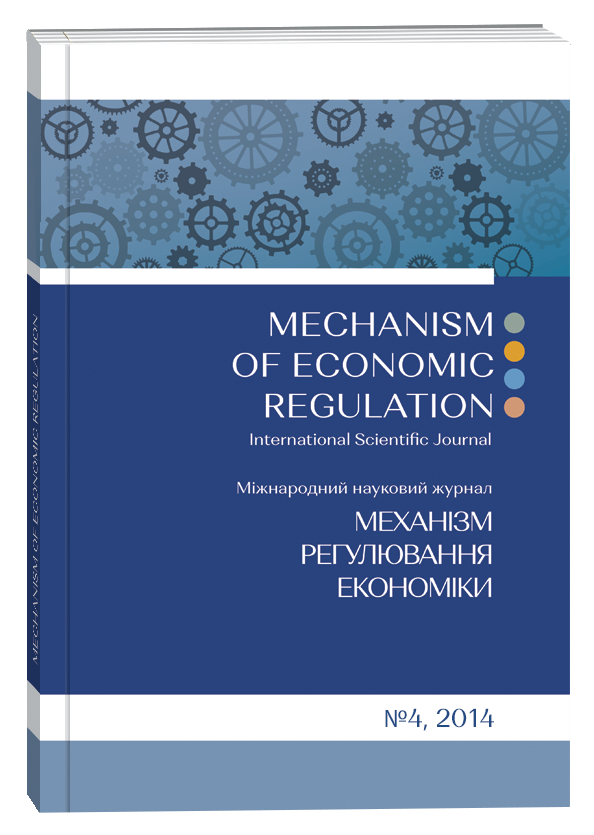IDEAS OF CYCLICAL DEVELOPMENT IN NATURE AND SOCIETY AND CIVILIZATION SHIFTS: ECONOMIC ASPECTS
Abstract
In the article on the base of noospheric approach is argues the necessity to stimulate the shift to using last achievements in new– VI and VII – technological orders. It is need to create the neutral in ecological sense model of economic development and growth that is able to overcome the trend to use fossil fuel. Thus it must be formulated the new system of values, in global economic sphere, that will come as Schumpeterian innovation. We show in the article that for creating of such innovation some financial conditions must being mature to correspond to the conditions of lower turning point of economic cycle, described yet by Schumpeter and Kondratieff. The change of basis energy resources as one of major moving forces of Kondratieff waves is defines the sustainability of economic system in ecological sense. This mechanism in the period of modern crises can be broken if the power of oil and connected with it roles in geopolitical allocation of the roles is stay still., It means the necessity to form new system of values, based on the idea of harmonic coexistence between humanity and nature and suggesting implementation of ecological innovations, that could solve the problem of energy dependence, famine and another socio-ecological problems on the periphery of modern global world, preventing new war disasters. By this way it is only possible to start new cycle of economic growth without dangerous of new world war.
References
Акаев, А. А. Экономические циклы и экономический рост / [Акаев А. А., Румянцева С. Ю., Сарыгулов А. И., Соколов В. Н.]. – СПб. : Издательство Политехнического университета, 2011. – 456 с.
Бадалян, Л. Г. История. Кризисы. Перспективы. Новый взгляд на прошлое и будущее / Л. Г. Бадалян, В. Ф. Криворотов. – М. : Либроком, 2011. – 288 с.
Вернадский, В. И. Автотрофность человечества / В. И. Вернадский // Русский космизм. Антология философской мысли / сост. С. Г. Семенова, А. Г. Гачева. – М. : Педагогика-Пресс, 1993. – 368 с.
Глазьев, С. Ю. Мировой экономический кризис как процесс смены технологических укладов / С. Ю. Глазьев // Вопросы экономики. – 2009. – № 3. – С. 26–38.
Кондратьев, Н. Д. Основные проблемы экономической статики и динамики. Предвар. эскиз. / Н. Д. Кондратьев. – М. : Наука, 1991. –567 с.
Кондратьев, Н. Д. Большие циклы конъюнктуры и теория предвидения / Н. Д. Кондратьев. – М. : Экономика, 2002. – 767 с.
Перес, К. Технологические революции и финансовый капитал. Динамика пузырей и периодов процветания / К. Перес. – М. : Дело, 2011. – 232 с.
Румянцева, С. Ю. Особенности современной фазы мировой экономической конъюнктуры / С. Ю. Румянцева // Вестник Санкт-Петербургского университета. Серия 5: Экономика. –2012. – № 3. – С. 3–19.
Туган-Барановский, М. И. Периодические промышленные кризисы. История английских кризисов. Общая теория кризисов / М. И. Туган-Барановский. – СПб. : Т-во О. Н. Поповой, 1914. – XII, 466 с.
Шумпетер, Й. Теория экономического развития (Исследование предпринимательской прибыли, капитала, кредита, процента и цикла конъюнктуры) / Й. Шумпетер ; пер. с англ. – М. : Прогресс, 1982. – 455 с.
Berry, B. J. L. Long-wave Rhythms in Economic Development and Political Behaviour / B. J. L. Berry. – Baltimore & London, 1991. –79 p.
Kuznets, S. Long Swings in the Growth of Population and in Related Economic Variables / S. Kuznets // Proceeding of the American Philosophical Society. – 1958. – CII: 1 – P. 33.
Kuznets, S. Economic Growth of Nations. Total Output and Production Structure / S. Kuznets. – Cambridge : Harvard University Press, 1971. – 363 p.
Shumpeter, J. Business Cycles : A Theoretical, Historical and Statistical Analysis of the Capitalist Process / J. Shumpeter. – New York : McGraw-Hill, 1939, Vol. 1. – 461 p.
Akayev, A. A., Rumyantseva, S. Yu., Sarygulov, A. I., Sokolov, V. N. (2011), Economic Cycles and Economic Growth, SainPetersburg, Izdatelstvo Politechnicheskogo Universiteta. (in Russian)
Badalyan, L. G., Krivorotov, V. F. (2011), History, Crises, Perspectives. The new view for past and future, Moscow, Librocom. (In Russian)
Vernadskiy, V. I. (1993), Autotrophy of Humanity, Russian Cosmism. Anthology of philosophic thought, ed. Bb S. G. Semenova, A. G. Gacheva. Moscow, Pedagogica-Press. (In Russian)
Glaziev, S. Yu. (2009), “World Economic Crises as a process of changes of technological orders,” Voprosy ekonomiki, 3, 26–38. (In Russian)
Kondratieff, N. D. (1991), The main problems of economic statics and dynamics. Preliminary sketch, Moscow, Naukа. (In Russian)
Kondratieff, N. D. (2002), Big cycles of conjuncture and the theory of foresight, Мoscow, Ekonomika. (In Russian)
Perez, C. (2011), Technological revolution and financial capital. The dynamics of bubbles and golden ages, Moscow, Delo. (In Russian)
Rumyantseva, S. Yu. (2012), “The peculiarities of modern phase of world economic conjuncture,” Vestnik Sankt-Peterburgskogo Universiteta, Seria 5: Ekonomika, 3, 3-19. (In Russian)
Tugan-Baranovsky, M. I. (1914), Periodical industrial сrises, Saint Petersburg, T-vo O. N. Popovoi. (In Russian)
Schumpeter, J. (1982), The Theory of Economic Development, Moscow, Progress. (In Russian)
Berry, B. J. L. (1991), Long-wave Rhythms in Economic Development and Political Behaviour, Baltimore&London.
Kuznets, S. (1958), “Long Swings in the Growth of Population and in Related Economic Variables,” Proceeding of the American Philosophical Society, CII: 1, 33.
Kuznets, S. (1971), Economic Growth of Nations. Total Output and Production Structure, Cambridge, Harvard University Press.
Schumpeter, J. (1939), Business Cycles: A Theoretical, Historical and Statistical Analysis of the Capitalist Process, New York, McGraw-Hill, Vol. 1.


